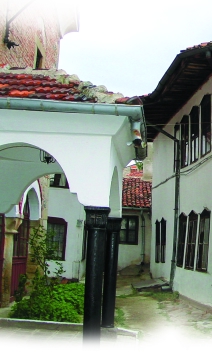 February
February
“Malak Sechko”. This is how elderly people call the month
for repentance, dedicated to the god of death – Februus.
In ancient Rome Februa was the name for the last holidays
of purification, connected with offerings.
The Bulgarian folk calendar gives one name, “Trifountzi”,
to
the first three days of the month. They are the symbolic
and mythological link of the dead ancestors with the coming
fruitful year.
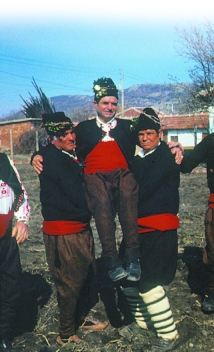
1 February
TRIFON ZAREZAN
In the classical folk calendar of the Bulgarians the first spring festival
is Trifon Zarezan, the day of vine-growers, gardeners and pub-keepers
– successor of the days dedicated to the Thracian god of merry-making
and wine Dionysus. According to some students of Thracian culture, Dionysus
is the creator of the world and the patron of birth.
For that reason his symbol, the wine, is also moist and warm. The day
is also called “the noseless”. A legend tells how Virgin Mary
pronounced a curse on Triphon to cut his nose because he made fun of her.
And the nose is an old symbol of masculinity. On this day very early in
the morning the woman of the house makes a ritual or “trifonski”
bread, slaughters a black hen and cooks it. When the sun rises everybodystarts,
with songs and music, for the vineyards.
There each owner digs with the sickle
round the biggest vine, pours red wine three times round the roots and
feeds the roots with ritual bread at four points, corresponding to the
four cardinal points. He spreads
ashes about and then he cuts three sticks from the vine. He 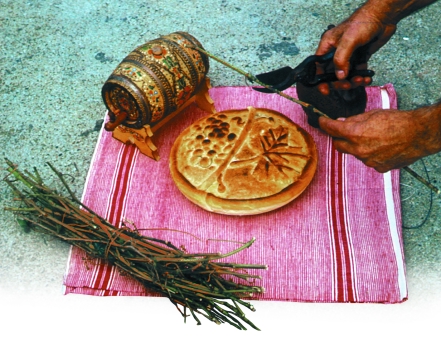
 twines
them into a wreath, ties it with a red thread, makes the sign of the cross
three times and pronounces the blessing: “May this year be rosperous!
Let’s gather a full bushel from each vine, let’s pour a bucket
of wine out of every stump so that it flows over the threshold!”
They eat – there, among the vines. The man who has produced the
largest quantities
twines
them into a wreath, ties it with a red thread, makes the sign of the cross
three times and pronounces the blessing: “May this year be rosperous!
Let’s gather a full bushel from each vine, let’s pour a bucket
of wine out of every stump so that it flows over the threshold!”
They eat – there, among the vines. The man who has produced the
largest quantities
of wine during the year becomes king, blessed by the king of the preceding
year. Then, singing and dancing, driving the king in an open cart (in
some regions carried on the arms of two men) so that “his legs do
not touch the ground’, as a messenger of God, they all start for
the king’s house where festivities last through the night. Nameday
of Trifon. Triphon also means ‘lover of merriment and pleasure’.
2 February PETLYOVDEN (Rooster’s Day)
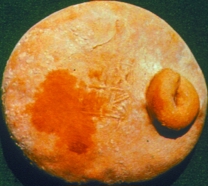 The
second “Trifounetz” is called Rooster’s Day and is in
its essence both a left and a right male day. Old people say that this
day is marked because when King Irod killed the infants in search of the
new king, a mother painted the doors of all neighbors with the blood from
the cut head of a rooster, forging the sign, and in this way saved her
son. Later
The
second “Trifounetz” is called Rooster’s Day and is in
its essence both a left and a right male day. Old people say that this
day is marked because when King Irod killed the infants in search of the
new king, a mother painted the doors of all neighbors with the blood from
the cut head of a rooster, forging the sign, and in this way saved her
son. Later
this legend was related to the ferocity of the janissaries but the holiday
remained. The rooster in Christian and pre-Christian cultures is the image
of the herald of sunrise. It is related to the notion of resurrection
of the dead, a symbol of the ever-resurrecting life.
3 February SEMEN DEN (Seed’s Day)
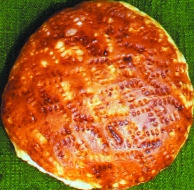 Bulgarians
all over the world call this day "Holy Mother" and believe that
if a woman wants to have a child, she must give out a "pinched corn
bread". How do you prepare a "pinched" bread? With your
fingers. With the fingers you make a sign of the cross on the still unbaked
bread. The dough is pinched many times, with the thumb and forefinger,
and on
Bulgarians
all over the world call this day "Holy Mother" and believe that
if a woman wants to have a child, she must give out a "pinched corn
bread". How do you prepare a "pinched" bread? With your
fingers. With the fingers you make a sign of the cross on the still unbaked
bread. The dough is pinched many times, with the thumb and forefinger,
and on
the four ends of the cross you put four balls of dough pierced with the
spindle. The baked bread is given out at a crossroads. When someone takes
the piece of bread he must make a sign of the cross for himself, for the
woman that gave him food, and say: This year pinched bread in your hand,
next year – dear child in your heart!
4 February. Nameday of Zhelyazko (iron).
Iron is a symbol of strength and solidity.
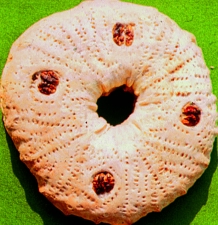 10
February CHOUMINDEN (Plague Day)
10
February CHOUMINDEN (Plague Day)
(St. Haralampius)
For this day women prepare a ritual bread with a big wreath of dough
and holes in four places – at the four cardinal points, like a cross.
While the bread is baked the woman of the house sanctifies a dish of honey
in the church and spreads the honey on the bread. Then she smokes it with
four grains of incense, over a ploughshare or a tile, and
breaks it in four. One piece she leaves at home, the other three she takes
to three houses. It is believed that in this way the house and the family
are protected against the plague and everybody will be healthy
and joyful during the year. The Greek Haralampios means ‘glowing
with joy’.
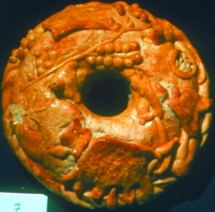 10 February. Nameday of Valentin,
10 February. Nameday of Valentin,
Valentina (from the Latin Valentinus ‘strong,
robust’).
People celebrate this day in honor of the draught animals. In each house, while it is still dark, they prepare the dough for the ritual buns. When the buns are ready, the man of the house takes the oxen out of the shed, combs them, and the woman takes out the buns in a sieve. Then she puts buns on the horns of each ox and the man takes them to the river. There he breaks the buns, dips them into the running water and feeds the animals for health. After watering the cattle, on coming back home the man summons the whole family and they all eat from the laid table standing. While eating the children moo, kick and the man of the house pronounces a blessing: “Let Vlas drag himself, drag himself deep down in the earth. But let him not take from our house!” “Amen!”, the others reply and believe that during the whole year people and animals will be healthy.
14 February ZADOUSHNITZA (All Souls’ Day)
The first All Souls’ Day for the year, before Zagovezni. People
go to church, light candles – “for the dead”, and give
out meals that the deceased liked most. In the past people prepared for
All Souls’
Day long time ahead and as it approached they mentioned the names of their
deceased more and more often. Thus All Souls’ Day and the days preceding
it became days of recapitulation of the good done. During these days men
don’t drink and are careful not to abuse the memory of those who
are no longer among them. On the evening before All Souls’ Day women
boil wheat, add ground sugar and go to bed early so they can go to the
graveyard before sunrise. There they pour wine on the grave, clean it,
give out what they have brought and sit down in silence looking at the
heap of earth that separates them from
the beloved person as though they don’t believe in death. Bulgarians
have a strange logic. They take death as a temporary phenomenon, like
life, which is also temporary. This is the lesson of the four seasons
of the
year when life dies and is reborn before their eyes. Life leaves wheat
in the barns just as a man must leave behind him the seeds of memory in
people’s minds.
14 February. Nameday of Valentin, Valentina.
This holiday became popular in recent years in honor of the Catholic St. Valentine.
15 February MESNI ZAGOVEZNI (the second Sunday before Lent)
Breaking fast is made with meat so the festive table contains only meat
dishes. In the week after Mesni Zagovezni people eat a lot of cheese,
butter and eggs. This is the last week in which the young people can go
to the village square, sing and dance the horo. Till Easter (Passover)
there follows food and spiritual fasting. For centuries the Bulgarians,
through traditional moral norms, have established the necessary eating
schedule for the year. The strict observation of the fast is supported
by a cycle of rituals and rules, fixing "starting fast" and
"breaking fast". "Starting fast" is a whole series
of practices introducing man into a system of restrictions, and "breaking
fast" is a return to the world of chaos and temptations. Fasting
in cosmogonic folk mythology has its origin in the belief in the rhythmic
change of chaos and order. From an aesthetic and biological point of view
fasting is connected with the rituals of seasonal transition and bringing
biological processes of man in harmony with those of nature. The social
aspect of fasting illustrates the traditional folk concepts of cyclic
birth and death in nature. In most ancient cultures fasting is practiced
as a form of voluntary restriction, repentance for bad thoughts and deeds
and mobilization of the spirit and the body to overcome future difficulties.
Temporary abstinence from certain foods and actions during fixed periods
of time is a way of purification and attainment of spiritual and physical
perfection. In this sense are
also the precepts of the mediaeval philosopher Basilius the Great that
fasting is “themother of health”, and satiation is “the
source of all evil”. Behind all concepts and beliefs one can see
the rational goals of fasting as a way of periodical cleansing of the
human body from harmful, toxic accumulations. The Easter fast is the longest.
It lasts seven weeks and ends on Easter. The second longest fast is the
Christmas fast – 40 days. There is two-week fasting before the days
of some saints, among whom Virgin Mary and Saint Peter.
22 February SIRNI ZAGOVEZNI (the first Sunday before Lent)
(Sirnitza, Maslenitza)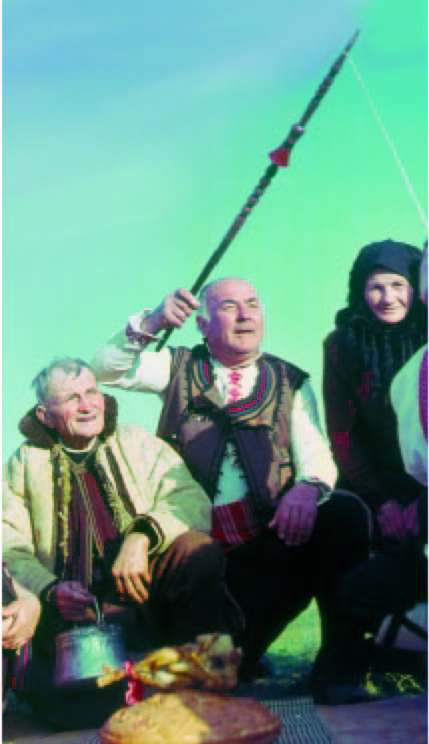
One of the favorite holidays for the Bulgarians in the early spring is
Sirni Zagovezni. It is also called Sirnitza, Proshka, Pokladi, Kourkouvnitza,
Olalia, etc. In the calendar it is always on Sunday – seven
weeks before Easter. The Sirni Zagovezni week is accompanied by many rituals
to secure fertility, prosperity, and health. On Tuesday and Thursday before
sunrise, and on Sunday at sunset young and old get together in the square
to dance quick horos.
In this way, through the ritual called “Gora” (forest) people
hope to stimulate earth, to make wheat grow high and cotton buds burst.
In the evening young people build fires, throw arrows and swirl fiery
hoops, with incantations for health, longevity, for relatives and friends,
for love: “Olalia, priest’s hat! Here’s, old priest,
the arrow, give me the young girl! I’ll give her a white distaff
so she gives me a white cradle!” Or: “Hey! The higher the
arrow flies the
longer my father lives!” Before going home, the young people “take
pardon” from the elder folks. After that
in each house the woman smokes the table with incense, the people in the
house "give each other pardon" and the man hangs a red thread
from the beam on the ceiling. On it
the woman ties, consecutively, a coal, a boiled egg and cheese, and turns
it in a circle to the right. The others try to take a bite at the respective
symbol. The one who
catches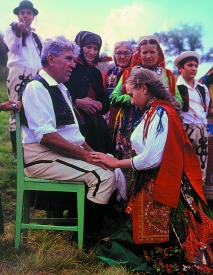 the first will care for home, the second one will be lucky throughout
the year,
the first will care for home, the second one will be lucky throughout
the year,
the third one will live longest. Then they
burn the thread, naming and divining which
harvest will be richest.
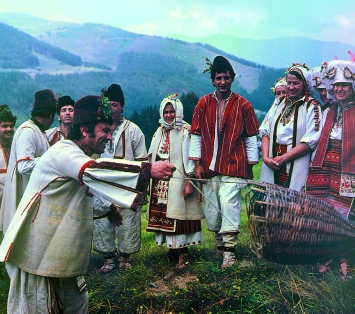
23 February KOUKEROVDEN (Mummers’ Day) (Curs’ Monday, clean)
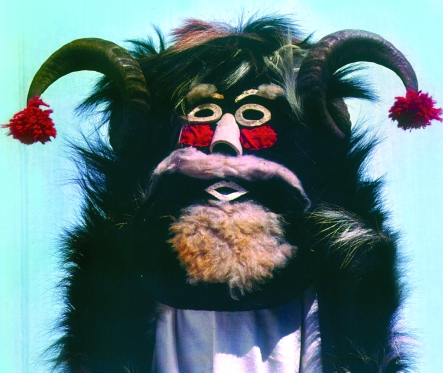
This is the first day of St. Theodore’s week when there is symbolic
“hanging” of dogs. According to folk beliefs this protects
them against rabbis. Starting from this day people in Southern and Eastern
Bulgaria dance the Mummer dances during the whole week. The mummers, young
men in disguise, visit all houses for health and prosperity and the hosts
give them generous presents. At the end the band of mummers symbolically
ploughs and sows in the village square, driving evil away and bringing
happiness and
prosperity to the people in the village. The mummer bride or “hadjibaba”
(as the leader of the mummers is called in some villages), standing upright
on the collar of the harnessed “ox-mummers”, blesses:
“Listen you all! Where mummer dances are danced let there be health
and prosperity! Let your gold coins be as many as the threads in my shirt,
let your children be as many as the bees in the hive, let the voices in
your house be as many as the sand in the sea! 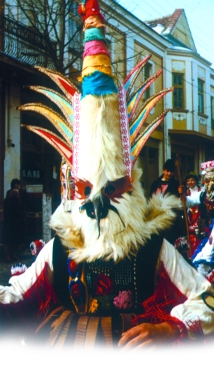 Let
evil be buried deep into the ground and let good reign!”
Let
evil be buried deep into the ground and let good reign!”
The day ends with a winding horo dance in the village square. There is
a legend left from old times: “A
father prepared a mummer costume for his son, watched the dance and said
– Jump, dear son, jump, my boy! To have wheat where the plough goes
and where the sheep bleat. Let this land trodden by evil forces
bear fruit… My grandfather has told me that long time ago the land
of the Bulgarians was like the Garden of Eden. It opened lavishly its
womb and gave people the fruits of their labor. They all lived happily,
ruled by a good and wise ruler. And his name was the same – he was
called Dobrodor. He respected the
neighboring rulers and they respected him. That is why the people in his
kingdom lived happily. The daughter of the Northern ruler, Zliana, was
envious of his happiness and sent him a sign. But he was in love with
another girl and she decided to take revenge. She made a vicious magic.
If a man puts the animals in the harness and starts ploughing the land,
his head will dry up and he will die before reaching home.
Many animals and people died. The people of the Dobrodor kingdom wondered
what to do. Spring was coming and the earth, all dried up, waited to be
ploughed and sown. The king fell ill with sorrow.
Weeks passed. His old farther wondered how to help him and finally found
an answer. He summoned all men in the kingdom and ordered them to skin
the dead animals and take the hides. He told them to make ox masks out
of them, put on women’s clothes, string bells round their waists,
and then go to the field, put themselves to the harness and plough the
land. The men did what the father told them. They took the hides, made
masks to cover their faces so that the evil Zliana could not affect them.
They succeeded in ploughing
and sowing the field. The outwitted evil witch burst with spite. This
day became a holiday for the people of Dobrodor. Since then, when spring
is on its way, the bells start ringing and men get together. They dress
in women’s clothes, put masks on their faces and begin blessing
the earth for more fertility and prosperity during the year. They jump
and jump to give fruit to the earth.
Then jump, my son, my dear boy! Let us have fruit where the plough goes
and where the sheep bleat…”
The next days in the week are described as black. Black Tuesday –
also called dry, deaf, cold, the worst of all Tuesdays in the year. Mad
Wednesday is observed as protection against madness. On Scatter-brained
Thursday women don’t spin the wool, don’t roll it on the distaff
to protect people against
dizziness and madness. Black Friday is considered the worst of all 12
Black Fridays during the year. Women on that day don’t wash themselves,
don’t comb their hair and don’t touch the spindle. It is only
on Saturday that a holiday comes.
23–25 February TRIMIRO
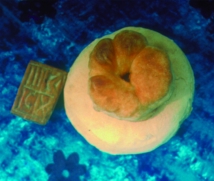 Typical
of the period of St. Theodore’s week is that people eat nothing
for three days. This is complete fasting – they eat no food, they
don’t even drink water. The Trimiro lasts Monday through Wednesday
following Sirni Zagovezni. On Wednesday morning people go to church, receive
Holy Communion and then go home where all the relatives and neighbors
are given a treat. The connection between the Trimiro and the cult of
the dead is obvious. Bulgarians
Typical
of the period of St. Theodore’s week is that people eat nothing
for three days. This is complete fasting – they eat no food, they
don’t even drink water. The Trimiro lasts Monday through Wednesday
following Sirni Zagovezni. On Wednesday morning people go to church, receive
Holy Communion and then go home where all the relatives and neighbors
are given a treat. The connection between the Trimiro and the cult of
the dead is obvious. Bulgarians
have the belief that a man fasts in order to be well “in the other
world”, to save his soul. In folk conceptions “in the other
world” each
person gets bread and water. But if he does not give out the same things
after the Trimiro, he won’t have them in “the other world”.
That is why on Wednesday the table
is laid with many lenten dishes (boiled wheat, fresh bread, beans, stewed
fruit) and bread and water is given to the guests. The guests, on their
part, bring presents and hand them saying: “May you be alive and
healthy so that you can celebrate the Trimiro next year too!” In
some villages the guests give money
to the host to buy himself a red pitcher or a bright red kerchief, which
he has to give someone else as a present and thus receive it in his afterlife
to pay his journey across the river to “the outer world”.
For that reason in some regions the Trimiro is also called "live
All Souls’ Day”, the souls’ day of the living. People
believe that by not eating for three days a man’s sins will be absolved
and he will go to Heaven. Those who have not gone through this will boil
in the tar. There is also the belief that by fasting one pays off his
mother’s milk and his own birth. The Trimiro is observed by people
of all ages, but those who fast keep it in secret. The ritual of fasting
is performed three, five, seven or nine years in succession or three times
in one’s lifetime, in order to be complete. If during the three
days of fast one feels faint, he is allowed to take only some soup of
boiled wheat or fruit. According to the popular belief, the one who fasts
"dies" and then
is born again. The one who cannot endure the fast remains unpurified but
he is also obliged to treat guests at table. A man who dies during the
Trimiro is considered to be the greatest sinner and in the Strandja Mountain
they don’t bury them in the graveyard but in the dumping ground.
It is believed that such people become vampires and the one to blame is
the “dry little Theodore” who represents the saint as a
mediator between God and the world of the dead.
28 February TODOROVDEN (St. Theodore’s Day)
(Horse Easter)
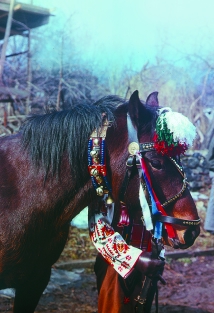
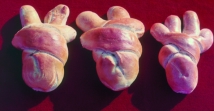 Toudoritza
or Horse Easter is a holiday for the health of horses and young brides,
newly wed during the winter. “Theodoros” is of Greek origin
and means ‘God’s gift’. On this day the women bake ritual
buns in the shape of a horse or a horseshoe. With
Toudoritza
or Horse Easter is a holiday for the health of horses and young brides,
newly wed during the winter. “Theodoros” is of Greek origin
and means ‘God’s gift’. On this day the women bake ritual
buns in the shape of a horse or a horseshoe. With
pieces of them they feed the horses and the young brides for health and
fertility. In some villages, when the mother-in-law gives the
piece of bun, the young bride kicks and neighs so that the young horses
that will be born will are healthy and agile.
The culmination of the holiday is the horse race, “koushia”.
At its end, the horseman who comes first in the competition leads the
horo dance in the village square. They all go to the house of the winner,
where
the feast and the festivities go on. This is the nameday of Teodor, Todor,
Todorka, Bozhidar, Bozhidara. They also receive guests and the table is
loaded, but with meatless dishes.